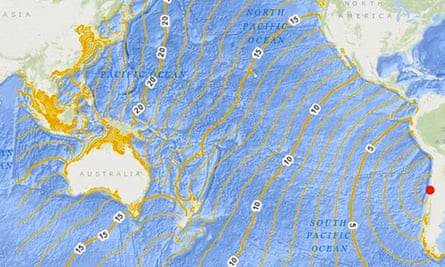Eight people have been killed and 1 million evacuated from their homes after a magnitude 8.3 earthquake struck just off the coast of Chile, sending powerful waves flooding into its coastal cities.
Coastlines on both sides of the Pacific had braced for possible tsunamis after the quake, although a tsunami alert originally issued for the entire Chilean coast was later lifted.
Chile’s ministry of the interior and public security said 20 people have been injured, but phone networks remain down in parts of the country so the full extent of damage and injury is not yet known.

A tsunami hit the coastal Chilean city of Tongoy at about 8.20pm local time, a little more than 25 minutes after the earthquake. Pictures appeared to show the city of Concón, popular with tourists, being deluged by waves.
Chile’s President Michelle Bachelet spoke on national television, saying Tongoy and Coquimbo had been extensively flooded and damaged. She declared a catastrophe zone in those areas and mobilised the military to help civilians and prevent looting.
“Once again we must confront a powerful blow from nature,” Bachelet told the nation.
Schools have been closed in several regions. The interior ministry’s national office of emergency has urged people not to return to their homes until they are told it is safe to do so.
The quake also sparked fears tsunamis could surge across the Pacific Ocean, with countries as far away Japan, New Zealand, Russia and the US states of California and Hawaii issuing warnings.
A watch was issued for the California coast: “A tsunami capable of producing strong currents or waves dangerous to persons in or very near the water is expected. The first wave may not be the largest.”
A tsunami advisory for Hawaii said a “major tsunami” was not expected but it warned of sea level changes and strong currents.
The New Zealand minister for civil defence, Nikki Kaye, urged east coast residents in the path of any potential tsunami to stay out of the the ocean, out of boats and off beaches.
The Pacific Tsunami Warning Centre said waves reaching one to three metres above the tide level were possible in French Polynesia, and that waves reaching 0.3 to one metre above tide level were possible for some coasts of New Zealand, Fiji, Hawaii, Mexico, Ecuador, Peru, Japan, New Caledonia, Samoa, Russia and other Pacific nations.
The PTWC later downgraded its warnings for some areas, including Hawaii. “However, sea level changes and strong currents may occur along all coasts,” it said, warning that larges swells arriving between five minutes and one hour could be ongoing.
The power of the initial earthquake was such that it could be felt across swaths of South America.
In the Chilean capital, Santiago, more than 230km from the epicentre of the quake, buildings swayed and thousands fled their homes to take refuge in the streets.
Car alarms were set off in Buenos Aires – more than 1,100km away on the Atlantic side of the South American continent.
Public buildings, including the campus of the University of Buenos Aires, were evacuated. High-rises in the neighbourhoods of Belgrano and Palermo swayed so much that many ran out into the streets. Other Argentinian cities including Rosario and Mendoza reported mass evacuations.
A magnitude 8.8 quake in central Chile in 2010 and ensuing tsunami killed more than 500 people, destroyed 220,000 homes and washed away docks, riverfronts and seaside resorts.
That quake released so much energy it shortened the Earth’s day by a fraction of a second, by changing the planet’s rotation.
Chile is one of the world’s most earthquake-prone countries in the world. Just off the coast, the Nazca tectonic plate plunges beneath the South American plate, pushing the towering Andes cordillera to ever-higher altitudes.
The strongest earthquake recorded happened in Chile in 1960 when a magnitude 9.5 tremor killed more than 5,000 people.
Comments (…)
Sign in or create your Guardian account to join the discussion